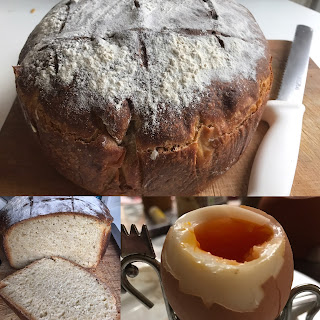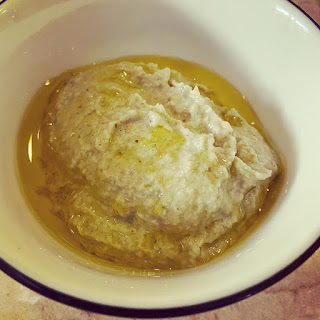Easy bread
Everyone secretly believes they would be the kind of person who would
bake their own bread … if only, if only, if only.
Bought bread is such a convenience, and so
cheap. I spent decades freezing sliced loaves of Hovis Granary and popping them
in the toaster as required.
But, in the same way that vegetarians lose
the memory of what meat tastes like, and decaf drinkers kid themselves that it
tastes like the real thing, bulk produced, accelerated yeast improvers and the Chorley
method don’t lie: once you’ve made your own bread at home there is no going
back.
By comparison supermarket loaves taste
gluey and bland, and they sit in one’s stomach long after eating, generating
wind and bloating and a general air of dissatisfaction.
A proper loaf, of real bread, is dense and
chewy and full of whatever you put in it – and nothing else! Whether wheat,
spelt, rye, corn, oats, seeds and nuts and
fruit, a basic loaf is just flour, yeast, salt and water. Mix them
together, add time (not yours – the dough will do it’s thing quietly without
any attention from you), and voila, the loaf (and kudos) is yours.
I proved that this weekend in what,
unintentionally turned in to more of a breadmaking experiment that I had
intended.
I count among my friends some incredible breadmakers –
Michelle Eshkeri at Margot Bakery in Finchley, Anton Grain in Bath – who have
turned dough and breadmaking into an art form. Complicated plaits and slashes
and intricate carvings elevate the loaf to another plane.
But we should start with the basic loaf,
which is what I was making. In fact, I was going to make bread rolls for
lunches I am catering this week .
My basic recipe is:
1kg flour
15g fine sea salt
15g caster sugar
30ml olive oil
2 heaped teaspoons of dried active yeast
250ml water
250ml whole milk
(Use 50/50 white and wholemeal or country grain or rye, spelt or any other strong flour to hand. Leave out the milk and double up on the water and it's dairy free. Add an egg (reduce liquid by 50ml) for a richer finish)
Weigh the ingredients in to your mixing
bowl (I use a Thermomix, but a KitchenAid or mixing by hand is fine).
Combine the water, milk and oil in a jug and
warm it in the microwave for 1 minute.
Add it to the dry ingredients and mix to bring
it together. In my machine that takes around 20 seconds. I then switch to dough
mode and knead it for 4 minutes before turning out into an oiled bowl. So at a
push I would call that 8 minutes.
In a normal mixer the kneading takes around
8 minutes, by hand around 15 minutes until you have a silky, pillowy dough. Turn it in to an oiled bowl and cover with a cloth.
Next, take a break. Go out, start writing
your novel, call your mother, look out the window, take the dog for a walk.
They all say (Paul Hollywood and other baking gurus) that yeasted dough takes
roughly an hour to double in volume, which is what you’re after. In my
experience it can take 3 hours or longer, so if you get delayed, miss the bus
or take a detour don’t worry, it won’t harm the dough.
Step 2, is simply to choose a receptacle to
bake your bread in: loaf tin, banneton, hand shaped and on a baking sheet … and
prepare it. I usually line with baking parchment because it is my best friend
in the kitchen but I have also been known to spray loaf tins with non-stick
spray (a good one, and make sure you get a good coating in the corners). How
long did that take?
Step 3. Turn the oven on. Tip the dough out
on to a floured surface and knock the air out of it by folding it over on
itself a few times. By now the yeast
will be softening the protein and the fat and sugar will be feeding the yeast
and they’re having a party in there and feeling fat and happy. Another 4
minutes?
Put the knocked-back dough in your prepared
baking container (I sometimes use an oven-proof saucepan or frying pan), cover
with a tea towel and put the kettle on. Maximum two minutes.
And this is where I proved that you can
ignore, forget, abandon, mistreat your bread dough and still end up with a
decent loaf at the end. I had intended to bake it on Saturday morning, knowing
I was going to be out all day and not returning until late that night. But I
forgot, and blithely left the house. This morning I returned to the kitchen and
was startled to see a still-proving loaf in the tin on the counter. Yikes. I
turned the oven on, sprinkled the top with flour and with a prayer to the bread
gods I popped it in and hoped for the best.
It was a big loaf – I could have made two
smaller ones – and took an hour to bake. During which time I read the papers,
drank coffee, chatted on Twitter.
I reckon in total the actual time spent, by
me, tending my bread was no more than 15 minutes over two days.
(The boiled egg took six minutes.)



Comments
Post a Comment